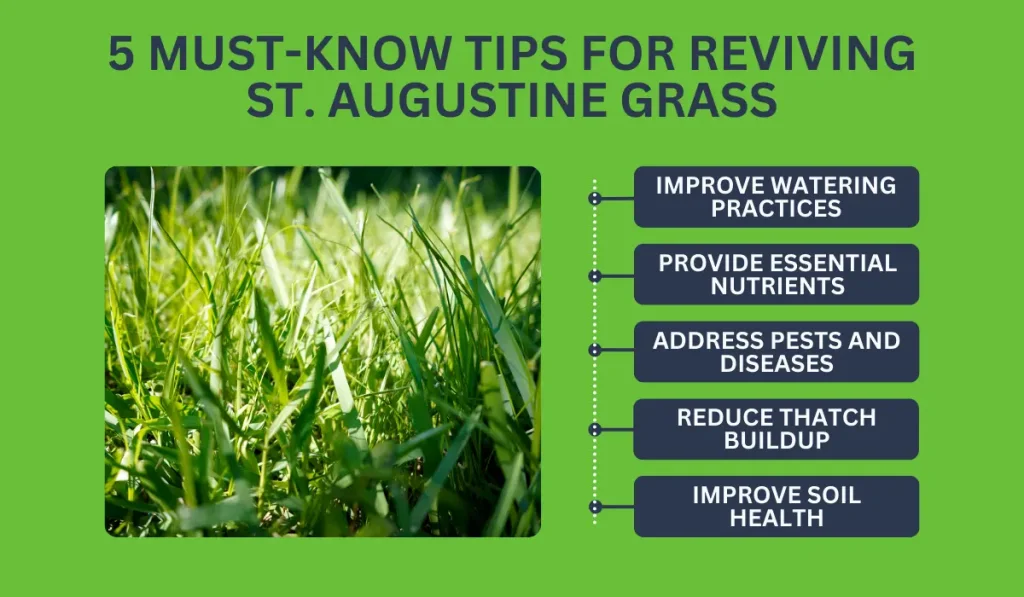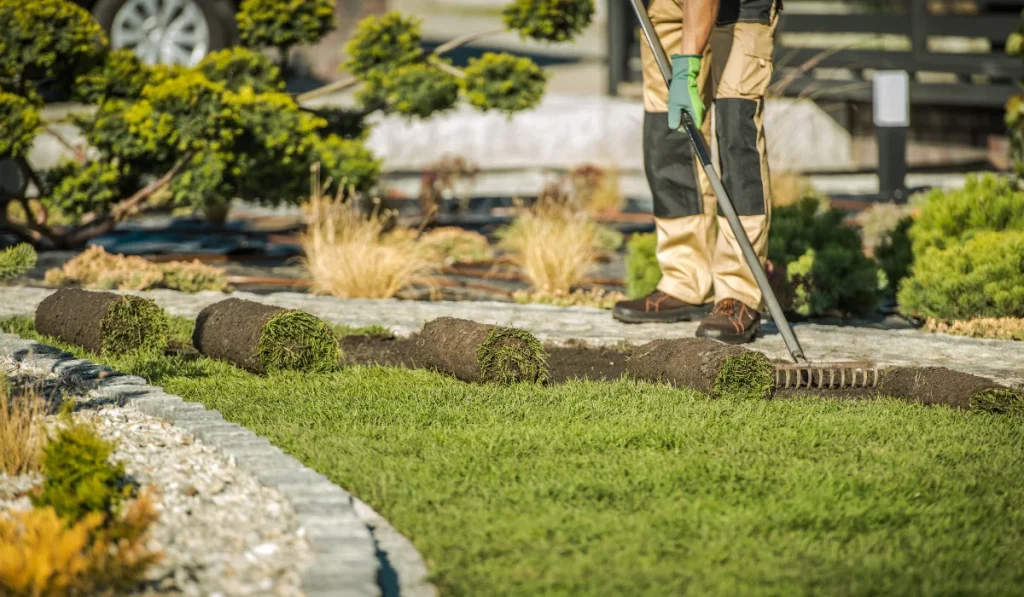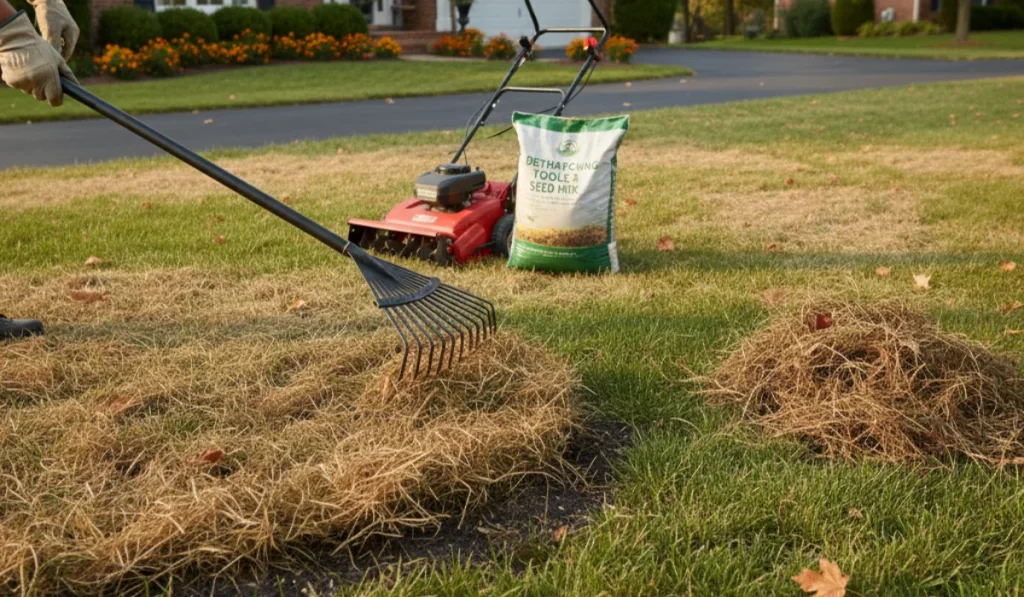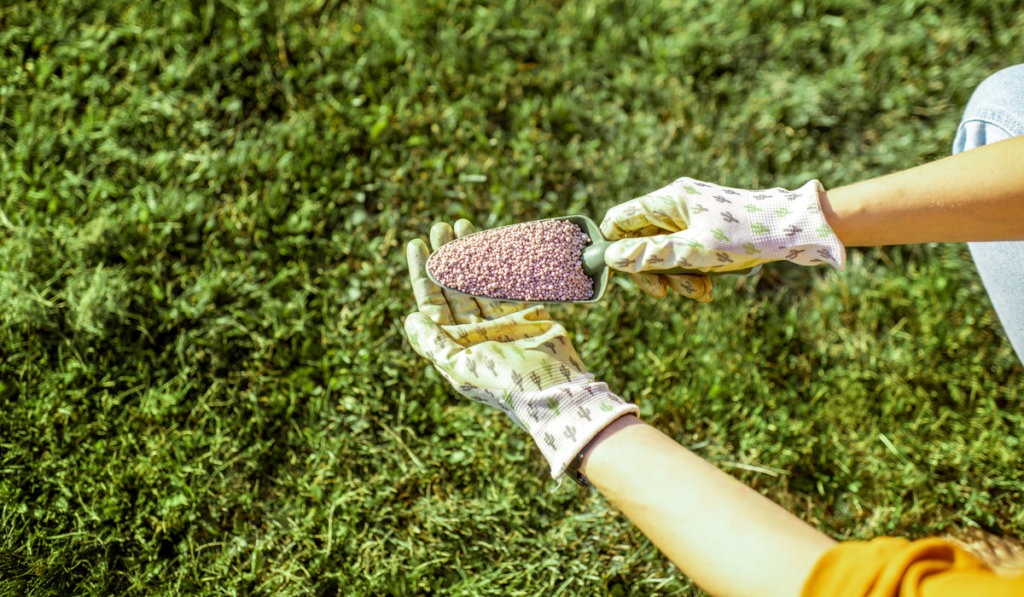Has your once-lush St. Augustine grass turned into a brown, patchy mess? Reviving it will take some care and attention.
Keep reading to learn exactly how to restore your grass to its former glory.
Key Takeaways
- Deep, occasional watering strengthens St. Augustine grassroots and prevents root rot.
- Fertilizing in late spring and early fall with a slow-release formula supports healthy grass growth.
- Pests and diseases, such as chinch bugs and brown patches, should be quickly identified and treated, often best done by a lawn care expert.
- Regular raking and lawn care prevent thatch buildup, with experts providing tailored solutions when needed.

Tip #1: Improve Watering Practices
To revive your dead St. Augustine grass lawn, you should pay close attention to how you water your lawn. Here’s what you can do to bring back a healthy lawn.
Deep, Infrequent Watering
Deep, infrequent watering ensures that the roots of St. Augustine grass grow strong and deep. Unlike shallow watering methods, this strategy helps the grass withstand dry spells and stress.
Aim to provide about an inch of water once or twice weekly. Track water use with a reliable method, such as a rain gauge or soil moisture meter.
Avoid Overwatering
Overwatering can lead to issues such as root rot and a weak lawn. As a warm-season grass type, St. Augustine doesn’t need constant saturation.
To avoid overwatering, let the lawn dry out slightly between waterings. But ensure it doesn’t reach the point of wilting.
Use a Sprinkler System or Hose
A sprinkler system or hose can help provide consistent watering when reviving your St. Augustine grass. Pick the right method for your lawn size and watering needs.
Sprinkler systems are the best choice for full coverage of larger areas.
Tip #2: Provide Essential Nutrients
Ensuring St. Augustine grass gets the essential nutrients it needs is vital for reviving its health. As homeowners, this involves various techniques, such as careful timing and selecting the right type of fertilizer.
Fertilize at the Right Time
Timing is crucial when fertilizing St. Augustine grass. Fertilizing too early or too late can lead to poor results.
The best times to fertilize are during the active growing seasons, typically late spring and early fall. During these periods, the grass blades and root system are most receptive to nutrients.
Choose the Correct Fertilizer Type
Selecting the right type of fertilizer is also essential. St. Augustine grass thrives on a balanced fertilizer that provides nitrogen, phosphorus, and potassium.
Generally, slow-release fertilizers are preferred because they provide a steady supply of nutrients over time.
Tip #3: Address Pests and Diseases
Reviving St. Augustine grass means paying attention to common pests and diseases. Identifying these issues early and using the right control measures are crucial to keeping your lawn looking its best.
Identify Common Pests and Diseases
Common lawn diseases and pest infestations can wreak havoc on St. Augustine grass. So, it’s essential to recognize these culprits quickly.
Here’s what to look for in common lawn problems:
| Pests or Diseases | Symptoms |
|---|---|
| Chinch Bugs | Yellow, brown patches |
| Grubs | Irregular patches of dead or dying grass |
| Brown Patch Disease | Circular, brown areas |
| Leaf Spots | Small, brown spots on the blades |
| Crabgrass | Fast-spreading grassy weed, appears lighter green |
Tip #4: Reduce Thatch Buildup
Thatch buildup can choke your St. Augustine grass, contributing to dead spots and unhealthy turfgrass. Proper management involves understanding what thatch is, how to remove it, and how to prevent future accumulation.
Understand Thatch
Thatch is a layer of dead grass stems, roots, and other organic material that accumulates between the soil and the living grass. It can prevent water, nutrients, and air from reaching the soil.
To spot thatch, look for these common signs:
- Spongy feel when walking
- Thick, brown layer near the soil
- Bare spots on the lawn
Dethatching Methods
Dethatching removes excess thatch to allow air, water, and nutrients to penetrate the soil effectively. Depending on the severity of the thatch buildup, several methods are available.
For light thatch, a manual rake might be sufficient. For thicker layers, consider using a dethatching rake or a power dethatcher. Renting a machine can be more efficient for larger areas.
Prevent Future Thatch Accumulation
After dethatching, lawn maintenance can help prevent future buildup. Regular mowing and proper watering are vital. Avoid over-fertilizing, which can contribute to thatch.
Only leave grass clippings on the lawn only if they are short. Annual aeration can also help reduce soil compaction and promote organic breakdown.
Tip #5: Improve Soil Health
Improving the health of any soil type is essential for a thriving St. Augustine lawn. This tip covers aerating the soil and testing the soil pH.
Aerate the Soil
Aerating your lawn helps break up compacted soil so air, water, and nutrients can reach the roots. This is particularly important for St. Augustine grass, which thrives better in well-aerated conditions.
For best results, aerate during the growing season when the grass is actively recovering.
Test Soil pH
Testing the soil pH helps ensure your lawn gets the right nutrients. St. Augustine grass prefers pH levels between 6.0 – 7.5. A simple soil test can determine if you need to adjust the pH.
Once the pH level is known, lime or sulfur should be applied to adjust it as needed. Repeat testing annually or every few years to maintain optimal conditions.



